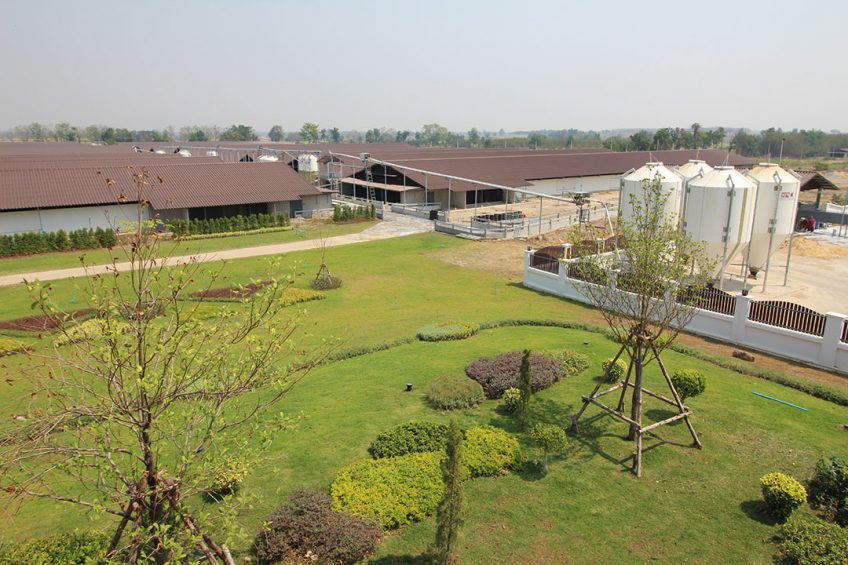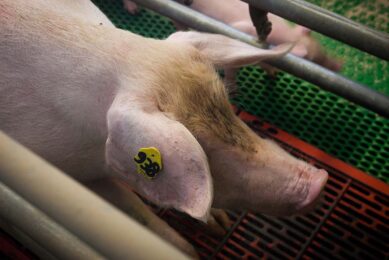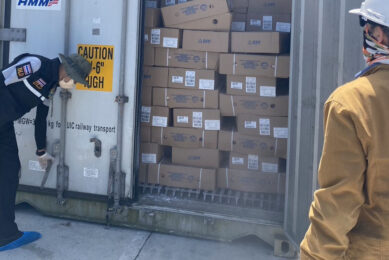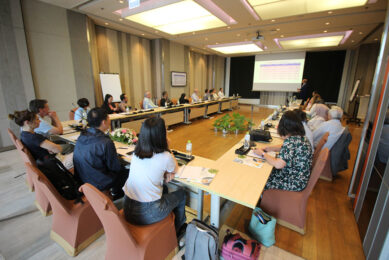Farm visit Thailand: A swine farm like a five-star hotel

Being a major integration allows Charoen Pokphand Foods in Thailand to regularly build new swine farms. Every time, new insights and new designs make the next farm a bit better than the previous one. Wichianburi Farm, opened in 2018, combines many aspects a modern sow facility needs to have.
A gate with shining gold and silver bars is brightly reflecting the sunlight. Behind it, in the far distance, buildings and silos. “From the outside it looks like a luxury hotel,” says Dr Apisit Kittawornrat with a grin, while signalling to an officer to have the gate opened. Dr Apisit is a veterinarian and assistant vice president of the pig business department within Thailand’s largest agribusiness Charoen Pokphand Foods (CPF).
ProfileWichianburi Farm is a 6,000 sow farm within the integration of Charoen Pokphand Foods. The 64.4 ha farm has a mix of grandparent (GP) and parent stock (PS) sows. The majority of the sows (5,500) are PS and produce weaner pigs for Charoen Pokphand Foods’ contract farmers in a 50 km radius around the farm, with an annual estimated target of 159,000 weaner pigs. Additionally, there are 500 GP sows for breeding replacement gilts in the 6 houses of the gilt developer unit (GDU), which is located 300 m away from the main buildings, comprising of 10 gestation units and 10 lactation units. In between is a biogas installation. On the other side of the farm is a quarantine unit, where newly arrived animals will have to stay for a month. The first round of sows were aiming for an average of 28.5 PSY. As these are still first-parity sows, the average is likely to go up. |
Wichianburi Farm, near Si Thep in Petchabun province may not be a hotel, but for swine staying in Thailand it is definitely a state-of-the-art facility. The CPF farm was completed in 2018 and basically it presents all the requirements a modern Asian farm needs to have these days. Essential ingredients include optimal biosecurity, raised without antibiotics, reuse of energy and group housing for gestating sows.
To zoom in on the last characteristic first – it was in late 2017 when CPF, driven by the global tendency to move away from gestation crates and further encouraged by animal welfare organisation World Animal Protection, announced switching to group housing for gestating sows. A tremendous operation given the fact that the company owns 800,000 sows. Basically, the company decided to do that in four steps:
- As from 2017, all newly built farms inside Thailand would get group housing;
- As from 2018, all newly built farms outside Thailand would get group housing;
- As from 2025, all existing farms in Thailand will have to be converted to group housing;
- As from 2028, all existing farms in Thailand as well as abroad will have to be converted to group housing.

Which system to choose?
An essential step was to decide which system of group housing fitted best for CPF. Dr Damnoen Chaturavittawong, the other veterinarian accompanying Pig Progress on this visit, is senior vice president of CPF’s swine veterinary service department. He explains, “With Electronic Sow Feeding systems there was the problem that we were sometimes dependent on critical components that had to come all the way from Europe. That just wasn’t very handy. That is why we chose stanchions.”

That is a system where feeding takes place in separate trough sections next to each other, just like in gestation crates, with the difference that there are no more crates. Dr Apisit adds, “In terms of cost price, this also was most suitable.”
Not many are allowed to enter Wichianburi Farm but those who get in will notice that the farm is very well equipped for visitors through various viewing galleries. One of them gives a great view of the gestation rooms, displaying much space for sows. The sows will stay in the gestation rooms as from 35 days into gestation – after their first pregnancy check – until day 107 which is just before farrowing. The sows are kept in groups of 18 animals, having 18 stanchions at their disposal on one end of the pen. The animals will be fed once a day, in the morning. During gestation, they will all receive the same feed, just the rations can vary depending on their stage of gestation. The pens are separated from each other by bars, allowing a maximum effect of evaporative cooling systems sending a fresh breeze through the entire room.

On the other side of each pen is a shallow water canal the width of a sow, where the animals can wade through to cool down – something they do regularly. The pen floor is sloping a tiny little bit, so any urine will automatically flow to the canal. The water in these canals is refreshed every day with its contents being transported directly to the biogas installation. Faeces is regularly manually removed from the pens as well, all leading to a clean atmosphere inside the building, according to both veterinarians. The biogas which is generated, in turn, takes care of a reduction of 50% of the farm’s electricity bill.
The system performs identical to gestation crates in terms of technical output, the veterinarians state – but it is clear that the sows are happier and the system leads to more animal welfare. In comparison to ESF the costs are a lot lower – and that is a bonus, given that the sows now have 2.4 m2 at their disposal compared to 1.43 m2 in the past. That cost price increase is compensated, the vets say, by the fact that the stanchion system does not require that much investment due to the absence of equipment.

Country Focus Thailand: A tiger cub ready to leap by: Dr John Strak, Editor Whole Hog
Farrowing rooms
A viewing gallery in one of the farrowing rooms shows the way the sows are kept in farrowing crates. The flooring is made by Big Dutchman, but the design of the crates are own design, explain Dr Damnoen and Dr Apisit. As a draught is being guided in front of the sows’ snouts, the piglets need a nest that is extra fenced off from the mother. That is why the farrowing crates come in a zig-zag shape and fit next to each other like a puzzle.

Within the farrowing crates, there is a bent horizontal bar which the sow will meet on her way to lay down. It will easily yield, but the feeling is just enough to make her hesitate for a moment, giving the opportunity for potentially crushed piglets to escape their fate of crushing.
On both sides of the viewing gallery corridor, it is possible to see different style farrowing crates, with ‘fingers’ and with ‘bars’. Dr Damnoen says, “One is more suitable for younger piglets as they can drink underneath the bars. The other type is more suitable for older piglets. We just observe and test the outcome, as to which works best. This way we keep learning and we take the experience with us for the construction of the next farm. This way no farm is ever the same.”

Antibiotic-free production
Another important trend that has been kept in the back of the mind of the CPF designers when planning Wichianburi Farm is the fact that customers in Thailand increasingly ask for antibiotic-free production. The aim is to do so at Wichianburi Farm, as no antibiotics are added to the feed; a process that is controlled and verified by third parties. Of course it can happen that an individual animal would need an antibiotic injection for treatment or welfare purposes. In those cases, the pen will be marked and the animal will receive a different colour ear tag. That makes it easier at the slaughterline to detect which animals will not be eligible to be marketed as antibiotic-free meat. The company hopes to soon start marketing the antibiotic-free meat under a new brand.
Biosecurity
In order to be able to produce without the usage of antibiotics, the farm has a top-notch biosecurity and very healthy genetic population. The farm is free from Porcine Reproductive and Respiratory Syndrome (PRRS), Aujeszky’s Disease, Foot-and-Mouth Disease and Porcine Epidemic Diarrhoea (PED). CPF made serious steps to keep pathogens away from the farm, e.g. by putting a fence with wire around the entire premises, but as well by making a showering-in procedure mandatory. The farm has ten parallel shower sluices.
A visit through the shower sluice comes with an initial spraying session with a disinfectant based on a quaternary ammonium compound, after which the shower cabin will automatically open after five minutes. Devices brought in need to be placed separately into a UV-box and will be sprayed before they are to be brought onto the farm.

On top of that, outside trucks cannot enter the facility. The feed truck will deliver its contents into four off-site silos, after which the feed is transported with pipes over the facility. Also the weaner pigs (at roughly 24 days) can be picked up at the other side of the fence by a pick-up truck. These will have to be near the farm for 24 hours downtime, so a proper disinfection can take place.
Not only is everything going in being taken care of – so is everything going out. The farm’s buildings are equipped with natural air scrubbers. In addition, plants and trees around the farm will have to absorb more of the odours emitted by the farm. In front of the farm, adjacent to the silver and gold entrance gate, a small forest is planned to reinforce the natural protection. Truth be told – one would almost forget this facility houses 6,000 sows.
African Swine Fever
What makes top-notch biosecurity extra important these days is the presence of African Swine Fever in Asia. It helps that there are not a lot of wild boar in the imminent surroundings of Wichianburi farm, but if one thing is clear it is that the virus is going to have a lot of difficulty to come in through other routes too.
So all in all, it may not be a luxury hotel for humans, but in the context of professional swine production, here is what a five-star facility can look like.
The latest information on the African Swine Fever virus and what you can do to prevent ASF entering your farm. Plus Pig Progress has been keeping track of the outbreaks and has created an interactive map with all the details. Check in out
Join 18,000+ subscribers
Subscribe to our newsletter to stay updated about all the need-to-know content in the pigsector, three times a week. Beheer
Beheer













 WP Admin
WP Admin  Bewerk bericht
Bewerk bericht